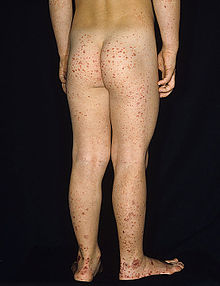User:Mr. Ibrahem/Henoch–Schönlein purpura
| Henoch-Schönlein purpura | |
|---|---|
| Other names | Schönlein–Henoch purpura,[1] IgA vasculitis |
 | |
| Typical purpura on lower legs and buttocks | |
| Pronunciation | |
| Specialty | Rheumatology |
| Symptoms | Purpura, petechiae, joint pain, abdominal pain[2] |
| Complications | Kidney failure, intussusception[2] |
| Duration | 4 weeks[2] |
| Diagnostic method | Based on symptoms without evidence of low platelets[2] |
| Differential diagnosis | Hemolytic uremic syndrome, idiopathic thrombocytopenic purpura, disseminated intravascular coagulation, lupus, Rocky Mountain spotted fever[2] |
| Treatment | Supportive care, corticosteroids, plasma exchange, immunosuppressants[2] |
| Frequency | Rare[2] |
Henoch–Schönlein purpura (HSP), also known as IgA vasculitis, is inflammation of the small blood vessels of the skin, kidneys, joints, and gastrointestinal tract.[2] Less commonly the brain or lungs may be involved.[2] Symptoms include purpura (purple bruises) or petechiae (small red dots) in the skin, and potentially joint pain and abdominal pain.[2] The rash primarily affects the legs.[2] Complications may include kidney failure and intussusception.[2]
HSP is often preceded by an infection, such as a throat infection or gastroenteritis.[2] The underlying mechanism involves build up of immune complexes containing the antibody immunoglobulin A (IgA) in small blood vessels, resulting in inflammation.[2] The diagnosis is based on symptoms without evidence of low platelets.[2]
Treatment is generally with supportive care, unless the kidneys are involves.[2] Paracetamol (acetaminophen) and occasionally NSAIDs may be used for the pain.[2] If the kidneys are involved treatment may include corticosteroids, plasma exchange, immunosuppressants, and ACE inhibitors.[2] Most people get better within 4 weeks though there is a risk of reoccurrence.[2] In adults, complications are more frequent.[3]
The condition is rare.[2] Children are most commonly affected and in this population it occurring in about 15 per 100,000 per year.[2] It is named after the German physicians Johann Schonlein and Eduard Henoch though was described earlier by William Heberden in the early 1800s.[2]
References[edit]
- ^ Rapini RP, Bolognia JL, Jorizzo JL (2007). Dermatology. St. Louis: Mosby. ISBN 978-1-4160-2999-1.
- ^ a b c d e f g h i j k l m n o p q r s t u v Roache-Robinson, P; Hotwagner, DT (January 2020). "Henoch Schonlein Purpura". PMID 30725937.
{{cite journal}}: Cite journal requires|journal=(help) - ^ "Treatment Challenges, Uncertainty Abound with IgA Vasculitis". The Rheumatologist. 2016. Archived from the original on 2018-12-16. Retrieved 2017-08-20.
